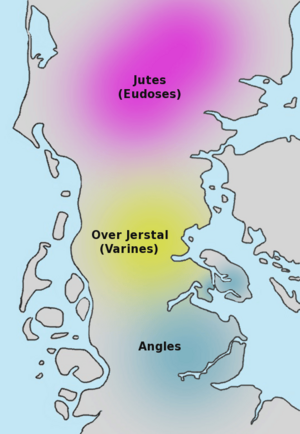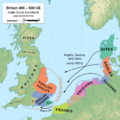Angles (tribe) facts for kids
| Ængle / Engle | |
|---|---|
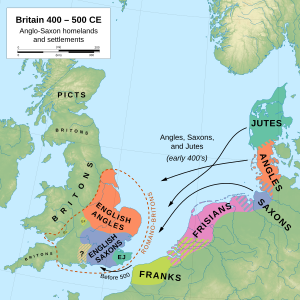
The spread of Angles (orange) and Saxons (blue) to the British Isles around 500 AD
|
|
| Regions with significant populations | |
| Jutland (Schleswig (Anglia), Holstein), Frisia, Heptarchy (England) | |
| Languages | |
| Old English (Anglic dialects) |
|
| Religion | |
| Originally Germanic and Anglo-Saxon paganism, later Christianity | |
| Related ethnic groups | |
| Anglo-Saxons, Anglo-Normans, English, Lowland Scots, Saxons, Frisii, Jutes |

The Angles (Old English: Ængle, Engle) were one of the main Germanic peoples who moved to Great Britain after the Roman Empire left. They helped create several kingdoms in Anglo-Saxon England. Their name is where the name England comes from, meaning "land of the Angles." Around 100 AD, a writer named Tacitus mentioned a group called the Anglii living east of the Lombards and Semnones, who were near the Elbe river.
Contents
Where Did the Name "Angles" Come From?
The name "Angles" likely first appeared in Latin as Anglii. It is believed to come from the area they originally lived in, the Anglia Peninsula. This place is called Angeln in modern German and Angel in modern Danish.
Some people think the name comes from the shape of the peninsula, which looks like a "hook." This is like the word "angling" for fishing. So, the Angles might have been known as a fishing people.
During the 400s, all the Germanic tribes who came to Britain were sometimes called Englisc or Angles. They all spoke Old English, which was also known as Englisc.
Pope Gregory I later shortened the Latin name Anglii to Angli. This became the common way to refer to them. The country they settled in was called Anglia in Latin. Later, Alfred the Great used the term Angelcynn (meaning "Angle-kin" or "Angle-people") to describe the English people.
What Did Ancient Writers Say About the Angles?
Tacitus's Writings
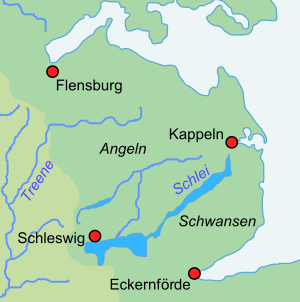
The earliest known mention of the Angles is in a book called Germania, written by Tacitus around 98 AD. Tacitus described the "Anglii" as a distant tribe. He said they lived with other tribes behind natural barriers like rivers and woods, making them hard to reach.
Tacitus didn't give their exact location. However, he noted that they, along with six other tribes, worshipped Nerthus, or Mother Earth. Her special place was on "an island in the Ocean." Most experts believe the Angles lived on the coasts of the Baltic Sea, likely in the southern part of the Jutland peninsula. This area had many inlets and swamps, making it difficult for outsiders like the Romans to access.
Ptolemy's Map
Ptolemy, who wrote around 150 AD, also mentioned the Angles in his atlas, Geography. His description is a bit confusing. In one part, he places the Sueboi Angeilloi (Angles) between the northern Rhine and central Elbe rivers.
Some historians think Ptolemy might have made a mistake. They believe the Angles were actually located northeast of the Langobardi, near the lower Elbe river. This is the area where the Angles are more commonly believed to have lived.
How Did Medieval Writers Describe the Angles?
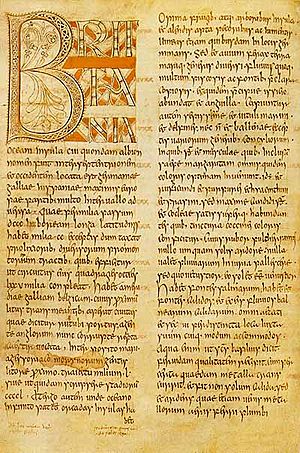
Bede, a famous historian, wrote that the Angles lived in a land called Angulus before they came to Great Britain. He said this land was "between the province of the Jutes and the Saxons, and remains unpopulated to this day." King Alfred the Great and other writers agreed that this place was Anglia, in the region of Schleswig.
A Norwegian sailor named Ohthere of Hålogaland also mentioned the Angles. He said that "on these islands dwelt the Engle before they came hither." This supports the idea that the Angles came from this northern European region.
The Angles are part of a famous story about Pope Gregory I. He saw some Angle children being sold as slaves in Rome. The story says Gregory was amazed by their looks and asked who they were. When told they were Anglii (Angles), he made a clever pun in Latin. He said, "It is well, for they have an angelic face, and such people ought to be co-heirs of the angels in heaven." This story supposedly inspired the Pope to send missionaries to bring Christianity to the Angles in Britain.
What Has Archaeology Taught Us?
The region of Schleswig has many ancient finds from the 300s and 400s. A large burial ground was found at Borgstedt. It contained many urns and brooches that look like those found in old graves in England.
Even more important are the discoveries at Thorsberg moor and Nydam. These sites had many weapons, jewelry, clothes, and farming tools. At Nydam, even ships were found! These finds help us understand what Angle culture was like before they moved to Britain.
Angle Kingdoms in England
After arriving in Britain, the Angles formed several kingdoms. These included Northumbria, East Anglia, and Mercia. At first, there were two northern kingdoms (Bernicia and Deira) and two central ones (Middle Anglia and Mercia). By the 600s, these had become two main Angle kingdoms: Northumbria and Mercia.
Northumbria was very powerful in Britain during the 600s. But then Mercia became stronger in the 700s. Both kingdoms faced huge attacks from Danish Viking armies in the 800s. The Angle royal families were mostly destroyed, and many Angles came under Danish rule, known as the Danelaw.
Further south, the Saxon kings of Wessex managed to fight off the Danes. In the late 800s and early 900s, the Wessex kings defeated the Danes and freed the Angles from the Danelaw. They joined their royal family with the remaining Angle royalty. This led to the creation of the "English" as a new group.
Today, the regions of East Anglia and Northumbria still use their original names. Northumbria used to stretch from what is now southeast Scotland (including Edinburgh) down to the Humber river.
Some Angles stayed in their original homeland in the northeastern part of modern Germany, on the Jutland Peninsula. A small area there is still called Anglia today. It forms a triangle from Flensburg to the City of Schleswig and then to Maasholm.
See also
 In Spanish: Anglos para niños
In Spanish: Anglos para niños
Images for kids


